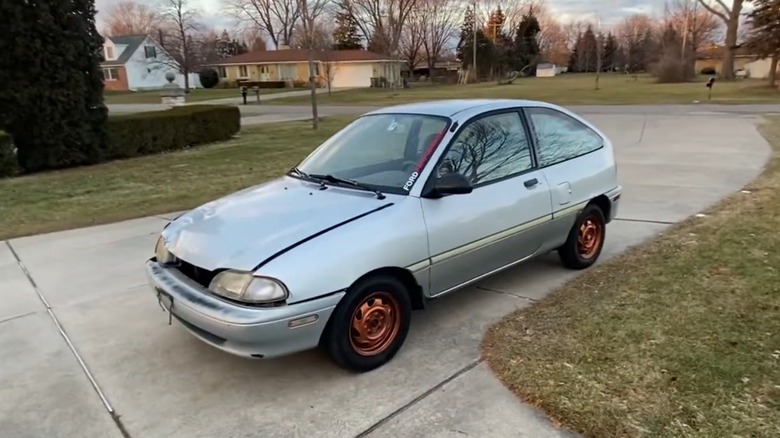What Happened To The Ford Aspire, And Was It Any Good?
The Ford Aspire launched in 1994 as a replacement to the Festiva, which was one of the most fuel-efficient Fords ever made. This subcompact car was a budget-friendly option to those looking for something basic. The Aspire came equipped with a small 1.3L four-cylinder engine that output 64 horsepower. While it won't raise your pulse behind the wheel, this Ford was fuel efficient, achieving up to 42 mpg on the highway. There were two trims offered in 1994 and 1995, the Base and the SE. For its last two years of production, the Aspire was only available in the Base trim. You could opt for either the two-door hatchback or four-door hatchback version of this Ford with the latter providing additional cargo space.
While not revolutionary, the Ford Aspire was economical, inexpensive, and provided a roomy interior. However, it struggled to step out of the shadow of the more popular Ford Escort, which reached 20 million units before production halted, making it one of Ford's best-selling vehicles of all time. In fact, in 1994, the year the Aspire was launched, Ford sold 336,967 Escorts, per GoodcarBadcar.com.
The Aspire couldn't compete with the Ford Escort or Dodge Neon
While the Ford Aspire was offered as low as $8,895, it wasn't low enough to provide value over superior alternatives. For example, the Dodge Neon was available for $9,475 and was considerably more powerful with 132 horsepower. The Aspire performs 0-60 mph in 13.8 seconds, whereas the more robust Neon can do it in under 8 seconds. The extra horses under the hood of the Dodge make daily commuting requirements like merging onto the highway easier.
The Ford Escort had already been around for years by the time Aspire entered the scene and is considered one of the most successful models in Ford history. You could get the Escort in a sedan, hatchback, or wagon variation with prices starting at $10,510 in 1994. There was also a GT trim which generated 127 horsepower. The Aspire couldn't match the Escort in terms of performance, and it didn't offer any interior advantages either. The Escort sedan with both rear seats folded down provided 35.2 cubic feet of space. The Aspire offers around 37.7 cubic feet of cargo room, which is only marginally larger than the Escort.
The Aspire was inexpensive, reliable, and included more safety features
There were plenty of subcompact cars competing for drivers' attention in the mid-90s such as the Saturn S-Series, Toyota Corolla, and Honda Civic. The Ford Aspire was cheaper than all these high-profile models, particularly when compared to the Corolla which was $4,413 more. The bargain price for the Aspire is what drew some interest with buyers as one owner remarked, "Great value for the price."
Several owners have also expressed that their Aspire was still going up to and beyond 200,000 miles with few mechanical issues. One reviewer explained their Ford "is now very near the 200,000 mile mark!" while another owner relayed, "With 150,000 miles on it, my biggest problem is rust that's starting to show."
Ford also included both a driver and passenger airbag system standard on all Aspire models, which was unusual for a budget subcompact at the time. There was an option to include anti-lock brakes as well, making the Aspire among the cheapest cars to offer these safety features.


